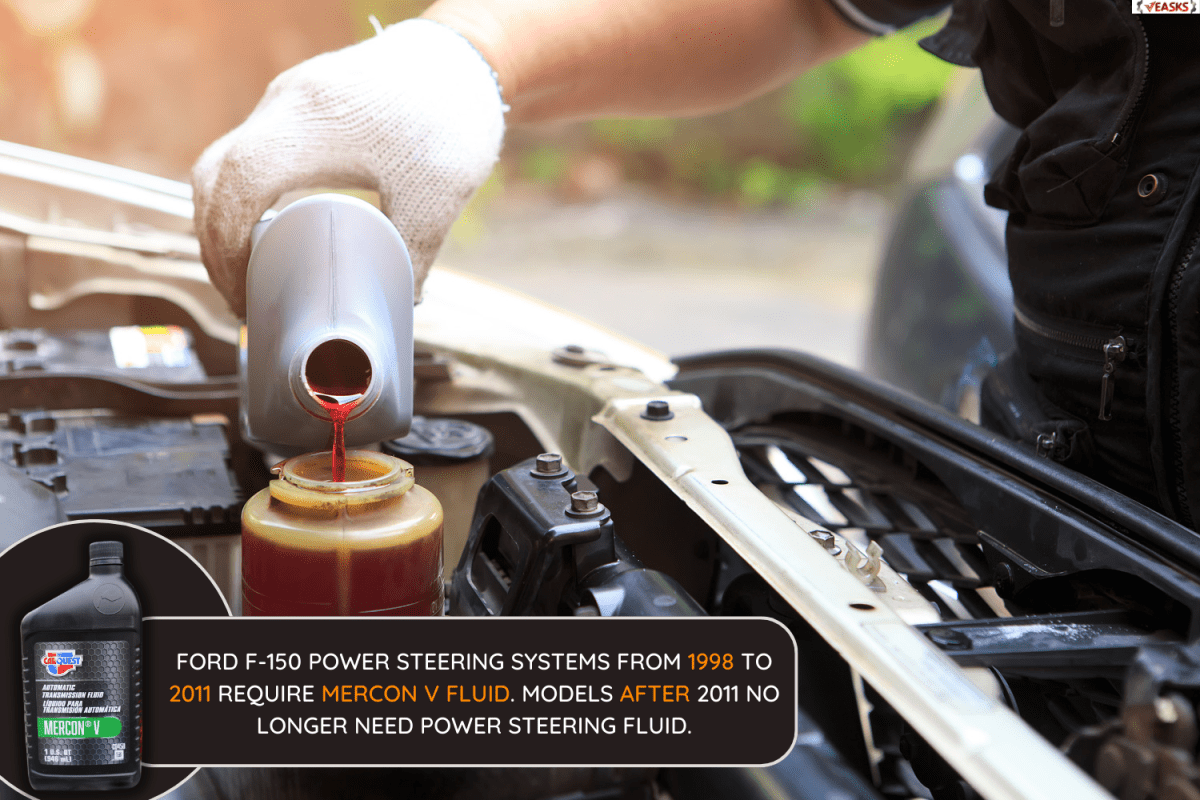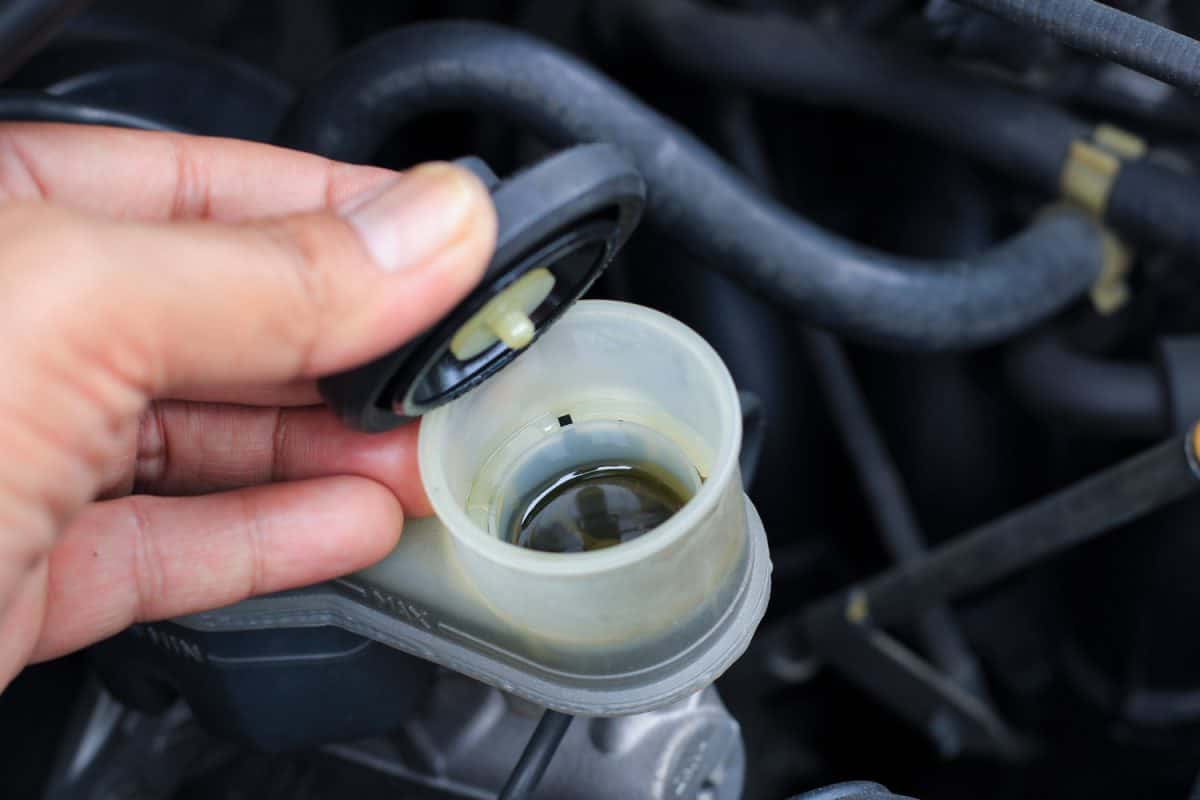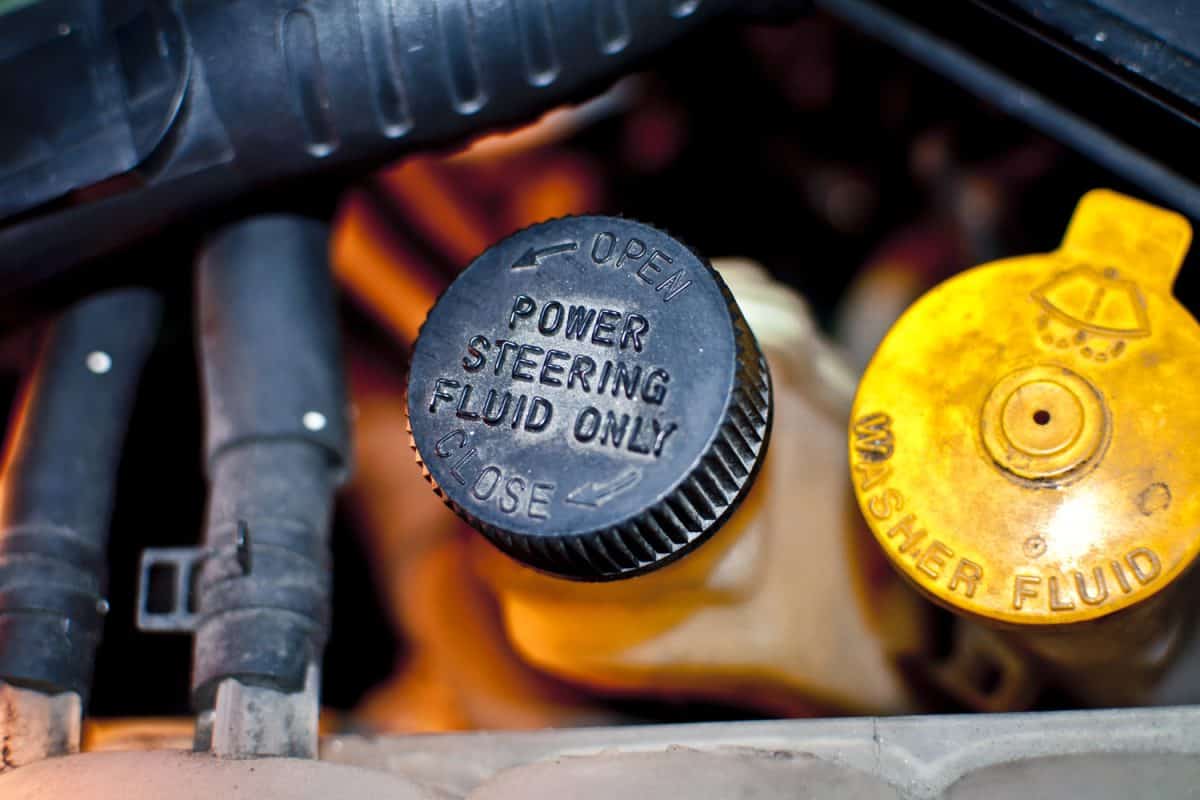Is it time to replace the power steering fluid in your Ford F-150, but you don't know the correct power steering fluid to use? You’ve come to the right place, for we have researched this question and have the answer for you.
Ford F-150 power steering systems from 1998 to 2011 require MERCON V fluid. Models after 2011 no longer need power steering fluid.
Let’s talk more about the power steering system in Ford F-150 in the succeeding sections and why you don’t need power steering fluid in Ford F-150 after 2011. Learn how to change the power steering fluid in your Ford F-150 in the sections below.
Read on!

Power Steering Fluid
Power steering fluid is a type of hydraulic fluid. Hydraulic fluid has special properties that make it ideal for this function.
The most important property of hydraulic fluids like power steering fluid is that they are not compressible. Incompressible fluids have consistent density and volume. This makes them ideal for transferring force in a hydraulic system.
Incompressible fluids are ideal for hydraulic systems because the amount of force applied to one end of the system will be multiplied by the area at the output end. If the fluid is compressible, instead of transferring the force across the hydraulic system, the fluid will simply compress and absorb the force.
A hydraulic system uses the effective area as a force multiplier. If the fluid is incompressible, then there is very little force lost in the system during operation.
Quick Air Release
Another property of the power steering fluid is its ability to easily eject air.
The power steering system must be free of air—similar to the brake system. Air is easily compressible, which means that the presence of air in the power steering system leads to loss of power. When you apply force on one side of the power steering system, the presence of air will prevent the transfer of power.
Thus, this property is important to keep air out of a hydraulic system.
Without this property, any air that makes it into the system during fluid changes will stay in the system and negatively affect its effectiveness. This can be dangerous because your car will become less responsive when you steer it.
Low Tendency To Foam
Power steering fluid's low tendency to foam helps prevent the formation of foam inside the hydraulic system.
Foam is normally made of gas that forms during the contact of gas and liquid. When liquid is agitated and is in contact with air, the agitation process can lead to the formation of foam.
This property helps prevent the formation of foam even with constant agitation of the liquid and the constant presence of gas in the system. Constant agitation of the fluid inside the power steering system comes from the constant movement of the steering wheel to maintain the correct course of your vehicle.
Part of the power steering system is the power steering liquid reservoir. When you fill the reservoir, there will always be air present close to the cap of the reservoir. You cannot fill the reservoir all the way to the brim.
The empty area of the reservoir is important to accommodate the expansion of the power steering liquid when its temperature rises during operation.
The presence of foam in the power steering system has a similar effect to air. Since foam is mostly air from the reservoir, its presence in the system brings with it the same dangers as having air in the system.
Low Volatility

Volatility is the property of liquids to turn into gas. A liquid with high volatility means that it evaporates easily, and liquids with low volatility don’t immediately evaporate.
This is important in hydraulic liquids, like the power steering liquid, to ensure that the level of the liquid remains the same even after a long time. Having low levels of power steering liquid is dangerous because it can cause you to lose control of your vehicle.
A secondary property of liquids with low volatility is that they have high boiling points.
This is an important property for a fluid that is regularly under high temperatures. Boiling hydraulic fluid can damage the seals and tubes inside the power steering system.
Hydraulic Power Steering
A hydraulic power steering uses the power from the steering wheel to move hydraulic fluid from the reservoir and into a pump. The pump is connected to the serpentine belt that draws power from the engine.
The pump increases the pressure of the power steering fluid as it passes through two tubes. The tubes go down to the rotary valve close to the rack and pinion assembly near the front axle.
The direction of where you turn your steering wheel determines which side of the rotary valve opens and which side remains closed. The valve that opens will allow the flow of hydraulic fluid into a piston that pushes that side of the axle, thus turning the wheels in that direction.
The turning of the wheels from one direction to the next is how you maneuver your vehicle in the right direction.

Disadvantage Of Hydraulic Power Steering
Very little has changed in the power steering system since it was introduced in the Chrysler Imperial in 1951. Modern advances in power conservation and improving the power output of the engine made it evident that the old hydraulic power steering system was not efficient enough.
The power steering pump is driven by the serpentine belt that draws power from the engine. This means that the power steering pump adds load to the engine and consumes some of the power that the engine generates. The power steering pump constantly draws power from the engine even when you’re not steering.
This is not ideal for maximizing the fuel consumption of the engine and improving fuel mileage.
What power steering fluid does a Ford F-150 use?

Ford F-150 trucks use the Motorcraft Mercon V Power Steering Fluid.
However, it is important to check your user manual to verify the type of power steering fluid that your F-150 needs—or whether it needs one.
Ford stopped using hydraulic power steering systems in 2012. Ford F-150 trucks from 2012 and up to the present use electronic power steering systems. This means that Ford F-150 trucks from 2012 no longer need power steering fluid replacement. An electronic power steering system uses an electric motor to provide additional force to make it easier to steer your vehicle instead of using a hydraulic system.
How to replace your power steering fluid?

It is a good idea to replace the power steering fluid every 30,000 to 50,000 miles or every three to five years. Check your user manual to verify the manufacturer’s schedule for power steering liquid replacement.
Fortunately, replacing it is quite simple. Just follow the steps below to replace your power steering liquid.
Preparing Your Vehicle
- Park your vehicle on level ground.
- Enable your parking brake.
- Set your transmission to Park(P)
- Jack up your F-150 on the jacking points.
- Place jack stands under your F-150 close to the front wheels.
- Give your F-150 a tug to make sure that it is secure.


BIG RED Torin Steel Jack Stands are available on Amazon through this link.
Draining
- Use a turkey baster to drain the liquid from the reservoir.
- Get under your truck and locate the power steering pump.
- Place a drain pan under the power steering pump.
- Disconnect the return line. It is the hose that goes to the pump that has a clip that you can remove.
- Move the steering wheel to the left and right until the fluid stops draining.


Norpro Plastic Nylon Baster is available on Amazon through this link.
Flushing
- Fill the reservoir with fresh fluid up to half full.
- Start the engine to drain the new fluid out and flush any old fluid and dirt in the system.
- Move the steering wheel to the left and right.
- Keep adding fluid if you need to. Stop draining when the color of the fluid flowing out is the same as the color of the new liquid.
- Turn off the engine.


Capri Tools Portable Drain Pan is available on Amazon through this link.
Topping Up
- Reconnect the return line. Use a new hose clamp.
- Fill the reservoir up to the “full” mark.
- Put the cap back on and turn on the engine.
- Let the engine run for 10 to 15 seconds.
- Turn off the engine.
- Remove the reservoir cap and refill up to the “full” mark.
- Lower your F-150 and go for a test drive.


Genuine Ford XT-5-QM MERCON-V Power Steering is available on Amazon through this link.
Conclusion
It is important to consult the user manual to find out what type of power steering system your F-150 uses.
If you enjoyed reading this article, you might find the articles below equally enjoyable to read:
Ford F-150 Ecoboost Whistle Noise – Why And What To Do?
Truck Smells Like Burning Plastic—What Could Be Wrong?



